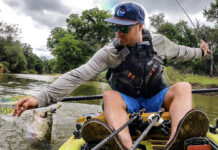Smallmouth and largemouth bass are two of the most popular sportfish. Targeting them with a kayak gives you a stealth and shallow-water advantage, but also heightens the angling experience of chasing these spunky, aggressive feeders. Apply these bass-catching tips and paddle your way to less-pressured waters for a bass bonanza. Don’t be surprised if the fishing’s so good, your thumb gets sore before your butt does.
Go Where Bass Boats Can’t
Before getting to presentation strategies, the biggest advantage a kayak offers is letting you fish small ponds and rivers. Look for smaller waters linked to a watershed known to hold big bass. Less-pressured waters often mean outstanding fishing.
Troll Crankbaits to Cover Water
All bass are vulnerable to the wobbling action of crankbaits. Cranks are particularly deadly when trolled from a kayak. Trolling is an excellent strategy when fishing a new water body or searching for fish.
Carry a mix of crankbait models. Use shallow-running lures to troll around weed flats and shorelines. Change to medium or deep-diving baits once you get out of the shallows.
Use a quality rod holder to secure your stick. Vary your paddling strokes to impart a stop-and-go or an erratic action to trigger hits.
Search Them Out With Spinnerbaits
If you prefer to cast instead of troll, a spinnerbait is an excellent all-round offering for bass. Fairly weedless and snag-free, you can cast this bait in almost anything except heavy cover.
A horizontal presentation, it’s perfectly suited for the sitting position of kayakers. A straight retrieve mixed with occasional pulls of the rod is effective. You can also work baits on a lift-fall sequence around drop-offs.
Work the Wood
Kayaks are perfect for navigating sunken wood areas difficult for larger boats to fish. Adopt a stealth approach and cast spinnerbaits, topwaters, crankbaits or plastics. Use a medium-heavy to heavy-power rod and strong line to prevent bass from wrapping you in cover.
Get Under Cover
The kayak angler’s low-seated position makes it easy to cast baits under cover. Using a side-arm cast, keep baits low to the water and toss them under shaded cover areas, like docks or overhanging trees.
Work on your accuracy and skip baits along the surface to slow down their speed, creating a natural slash entry into the water.
Fish Rivers from Shore
On rocky, winding rivers fishing from shore is a great way to work current areas, especially for smallmouth. Easier with a sit-on-top kayak, find a suitable spot to beach the rig on shore and then cast jigs and crankbaits to moving water. Look for eddies and seams where fast and slow-moving water combine. Boulders and sunken logs are other prime spots to toss baits. Once you’ve worked all you can from shore, simply float down to the next stretch of river.
Slip Through the Slop
Once of my favourite ways to fish largemouth bass is casting topwater frogs around thick surface weeds. Excitement is an understatement when fish hit, sending water and weeds flying and your heart rate soaring. Weeds wrap around paddles making manoeuvrability challenging, but the effort is worth it. Dropping an anchor on the edge of the slop prevents you from getting pulled into the thick stuff when locked in a tug-of-war with a bruiser buried in the weeds. Heavy tackle is a must for fishing thick cover.
Drift with Jigs
Drift fishing catches bass. Although kayaks are less likely to spook fish than larger boats, you still run this risk when you pass over the shallows. I prefer drift fishing over deeper water, starting at 12 to 15 feet depending on water clarity. You can use a variety of lures, but perhaps the most effective are soft plastics.
Tube and grub jigs are one option. When fished near bottom and lifted on small hops these baits take all bass species. Prime areas include the edge of deep weed lines, rocky reefs and points. Avoid snags in rocky spots by swimming jigs a foot above the floor.
Topwaters: Where Calm Meets Calamity
I’ve already alluded to using soft plastic frogs for largemouth, yet hard plastic baits excel in open water. A variety of baits are available, but the easiest models to work seated in a kayak are poppers and bladed baits. Toss baits over any depth of water or cover areas where bass might hold. Vary retrieves from extremely slow to quick scurries across the surface. Be alert at all times too, I’ve had bass follow right to my kayak and then crush the lure right at boat-side.
Recommended Outfits
For working heavy cover opt for a medium-heavy to heavy-power rod. Spool the reel with at least 17-pound monofilament or copolymer line. Another alternative is 40- to 50-pound superline. For open water applications, a medium-power spinning rod teamed with 6- to 10-pound monofilament or 30-pound superline will suffice. In general terms, baitcasting outfits are recommended for casting heavier baits and working thick cover. You may find using these outfits from a kayak requires you to re-learn the mechanics of casting. Alternatively, a heavy-action spinning outfit can be just as effective.
Tim Allard is a field editor for Ontario Out of Doors, Canada’s largest circulation outdoor sportsmen’s magazine. His website is timallard.ca.







